 |
| Ormonde (GB) |
 |
| Ormonde (GB) |
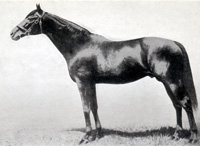 Ormonde Sire Line  Bend Or ORMONDE Orme Flying Fox . Ajax . Teddy Orby  Hugh Lupus Grosvenor (1825-1899), 1st Duke Of Westminster, was reputedly the richest man in England. He inherited Eaton Hall in Cheshire, where his grandfather had bred and raised Touchstone (br c 1831 Camel). He is the only person to have ever bred two triple crown winners, Ormonde and Flying Fox. |
Ormonde b c 1883 (Bend
Or - Lily Agnes, by Macaroni). Sire Line
Bend
Or. Family 16-h. Bred and owned by Hugh Lupus Grosvenor (1825-1899), 1st Duke of Westminster, Ormonde was doubtlessly one of the greatest racehorses of the nineteenth century. Said to have been the richest man in England the Duke has the distinction of being the only person to have bred two triple crown winners, Ormonde and his grandson Flying Fox (b c 1896 Orme). He also bred his sire, Bend Or (ch c 1877 Doncaster), with whom he won the Derby. He had additional success with Shotover (ch f 1879 Hermit) in the Two Thousand Guineas and the Derby and with Farewell (ch f 1882 Doncaster), a three quarters sister to Ormonde, in the One Thousand Guineas. His dam, Lily Agnes (b f 1871 Macaroni), was also one of the best of her generation, winning eight races, mainly Queen's Plates, as well as the Doncaster Cup and the Ebor Handicap. In the latter she defeated the exceptional fillies Apolgy (ch f 1871 Adventurer), winner of the One Thousand Guineas, Oaks and St Leger Stakes as well as the Ascot Gold Cup, and the Cesarewitch and Goodwood Cup winner Aventuriere (b f 1871 Adventurer). Lily Agnes developed respiratory problems late in her four year old year, sufficiently severe to prompt jockey John Osborne to note that he could hear her approach before he saw her. She did her best running earlier that year, however the problem did not prevent her winning several races as a five year old.
In 1885 Ormonde won the 6f Post Sweepstakes at Newmarket by a length, beating the Duke Of Portland's Modwena (b f 1883 Galopin) and the Duke Of Hamilton's Warbler (b c 1883 Petrarch). His second win came in the 6f Criterion Stakes at Newmarket by 3 lengths, defeating Mr Manton's Oberon (b c 1883 Galopin) and Prince Soltykoff's Mephisto (ch c 1883 Robert The Devil). His third win was for the 7f Dewhurst Plate at Newmarket by 4 lengths, over the Duke's Whitefriar (ch c 1883 Hermit) and R Peck's Murdoch (ch c 1883 Muncaster). In 1886 he won the 8f 2000 Guineas Stakes at Newmarket by 2 lengths, from R Vyner's Minting (b c 1883 Lord Lyon) and Mephisto. He then won the 12f Derby Stakes at Epsom by a length and a half from R Peck's The Bard (ch c 1883 Petrarch) and Mr Manton's St. Mirin (b c 1883 Hermit). He followed this with a win in the 8f St James's Palace Stakes at Ascot by three quarters of a length, from T Jennings Jr's Calais (b c 1883 Altyre) and Lord Hasting's Seaton (b c 1883 Master Kildare). He next won the 12f Hardwicke Stakes at Ascot by 2 lengths, from Lord Hasting's Melton (b c 1882 Master Kildare) and Prince Soltykoff's Silver (b c 1883 Sterling). He also won the 14f+ St. Leger Stakes at Doncaster by 4 lengths, from Mr Manton's St. Mirin and T Jennings's Exmoor (b c 1883 Vestminster). Then he won the 10f+ Great Foal Stakes at Newmarket by 3 lengths from Prince Soltykoff's Mephisto and the Duke's Whitefriar. He walked over for the 16f St Leger Stakes at Newmarket. He also won the 10f+ Champion Stakes at Newmarket by a length, from Mr Manton's Oberon and Prince Soltykoff's Argo Navis (b f 1883 New Holland). He won a 10f+ Free Handicap Sweepstakes at Newmarket by 8 lengths, from Prince Soltykoff's Mephisto and Mr Sassoon's Theodore (b c 1883 Sir Bevys). And finally he walked over for a Private Sweepstakes at Newmarket, receiving forfeit from Lord Hasting's Melton and R Peck's The Bard. In 1887 he won the 8f Rous Memorial Stakes at Ascot by 6 lengths, from Capt Machell's Kilwarlin (br c 1884 Arbitrator) and J H Houldsworth's Agave (bbr f 1884 Springfield). He again won the 12f Hardwicke Stakes at Ascot by a neck, from R Vyner's Minting and H T Barclay's Bendigo (br c 1880 Ben Battle). In his final race he won the 6f Imperial Gold Cup at Newmarket by 2 lengths, from Sir G Chetwynd's Whitefriar and Lord Hasting's Lovegold (b c 1884 The Miser). He went to stud at Eaton Hall in Cheshire in 1888 and got the good winner Orme (b c 1889) and Goldfinch (ch c 1889), sire of the One Thousand Guineas winner Chelandry (b f 1894), in his first season. Leased to Lord Gerard at Moulton Paddocks, Newmarket, the following year he caught a chill and was returned to Eaton where he duly recovered. However, despite much public criticism, the Duke determined to sell him abroad reasoning that since both he and his parents were roarers he would be a detriment to English bloodstock and that a warmer climate might offer some remediation for his condition. Sold to the Argentinian breeder Senor Bocau for £12,000 he was purchased in 1894 by Mr Macdonaugh of California for £30,000. He covered at the Menlo Stock Farm, where his stock was said to be of good quality but due to his previous illnesses his offspring were few in number. Ormonde died in California in 1904. |
|||||||||||||||||||||
| Orme (GB) | ||||||||||||||||||||||
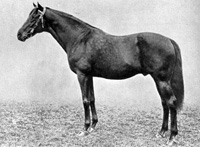 Photograph by W A Rouch © Thoroughbred |
Orme b c 1889 (Ormonde - Angelica, by Galopin). Family 11-c. | |||||||||||||||||||||
| Bred and owned by the 1st Duke of Westminster, Orme was a half brother to the good winner Blue-Green (br c 1887 Coeruleus). He was foaled at Lord Gerard's stud at Newmarket, his dam returning to Ormonde, who that year was leased. Orme's dam Angelica (b f 1879) never ran but was a full sister to the mighty St. Simon (br c 1881 Galopin). She had been bred by Prince Batthyany and was sold as a yearling to Taylor Sharpe for 50 guineas and the Duke bought her privately in 1886 whilst she was carrying Blue-Green. | ||||||||||||||||||||||
|
|
||||||||||||||||||||||
|
||||||||||||||||||||||
|
|
||||||||||||||||||||||
| Trained by John Porter
his 2 year old season was most satisfactory. He started 6 times and won
five of these with a 2° place finish in the other. However, his 3 year
old season suffered from nearly as much controversy as the kerfuffle
engendered over the identity of
his grandsire. Afflicted by blisters under his tongue, it was
initially thought that he had a sore throat, then perhaps a bad
tooth, and ultimately that he had been poisoned with mercury. Indeed the
Duke offered a £1,000 reward for information that would lead to the
conviction of the person who had poisoned his horse. For several days he
was said to have hovered between life and death, but ultimately his
robust constitution allowed Orme
to recover. Nevertheless he missed running in the the classics. In all he ran 18 times over 3
years and won 14 races and £32,526. In 1891 Orme won the Richmond Stakes at Goodwood, beating Flyaway (br f 1889 Galopin) and Bellefontaine (ch c 1889 Trappist). He next won the Prince Of Wales's Stakes at Goodwood, beating Dunure (b c 1889 St. Simon) and Galeopsis (b g 1889 Galopin). He finished 2° to the Middle Park Plate winner Signorina (br f 1887 St. Simon) for the Lancashire Plate at Manchester, beating the future Goodwood Cup and Queen's Vase winner Martagon (b c 1887 Bend Or). In his next outing he won the Middle Park Plate at Newmarket by 2 lengths from the Wokingham Stakes winner El Diablo (b c 1889 Robert The Devil) and the Yorkshire Oaks and Park Hill Stakes winner Gantlet (b f 1889 Galopin). He also won the Dewhurst Plate at Newmarket from El Diablo and Hatfield (b c 1889 Bend Or). In his final race of the year he defeated Esmond (b c 1889 Lowland Chief) and Lucellum (b c 1889 Chippendale) for the Home-Bred Foal Post Stakes at Newmarket. In 1892 he won the 10f Eclipse Stakes at Sandown Park by a neck, beating the Sussex Stakes winner Orvieto (b c 1888 Bend Or) and St. Damien (br c 1889 St. Simon). He then won the 8f Sussex Stakes at Goodwood by a head, beating Watercress (br c 1889 Springfield) and Bushey Park (b c 1889 Hampton). He was unplaced for the 14f+ St. Leger at Doncaster, won by the brilliant La Flèche (br f 1889 St. Simon) and the Derby winner Sir Hugo (ch c 1889 Wisdom). He fared better in his next appearance winning the 10f Great Foal Stakes at Newemarket by a length and a half, beating Versailles (b c 1889 Hampton) and Dunure. He also won the 10f Champion Stakes at Newmarket by 2 lengths, beating Orvieto. He then won the 8f Limekiln Stakes at Newmarket by 3 lengths, beating El Diablo and Sir Hugo. His last win of the year came in the 6f Subscription Stakes at Newmarket by a length, beating Porridge (ch c 1888 Monarch Of The Glen) and Bel Demonio (ch c 1887 Robert The Devil). His last race of the year was the next day, a 10f Free Handicap Sweepstakes at Newmarket, won by El Diablo, in which Orme finished 2°, beating Craven Stakes winner The Lover (ch c 1889 Charibert). In 1893 he won the 8f Rous Memorial Stakes at Ascot by 2 lengths, beating Lady Lena (ch f 1889 Cylinder). He then won the 10f Eclipse Stakes at Sandown Park by half a length, beating Médicis (ch c 1890 Robert The Devil or Florentine) and La Flèche. He next won the 10f Gordon Stakes at Goodwood by a neck, beating La Flèche yet again and Watercress. At Newmarket Houghton he lost his final race, the Limekiln Stakes, to Childwick (br c 1890 St. Simon) by 3-4 of a length, finishing 2° and beating Pilot (b c 1889 Pell Mell). Orme went to stud at Eaton. His sire line descends through two sons: triple crown winner Flying Fox (b c 1896) and Derby winner Orby (ch c 1904). His daughter Witch Elm (b f 1904) won the 1000 Guineas and Cheveley Park Stakes. Another daughter, Topiary (bbr f 1901), became the dam of St. Leger winner Tracery (br c 1909 Rock Sand). Orme was champion stallion in England in 1899. Suffering from the ravages of teeth problems, he was humanely destroyed at the Eaton Stud in Chester on September 17, 1915, and he is buried in the yard next to his dam. |
||||||||||||||||||||||
| Flying Fox (GB) | ||||||||||||||||||||||
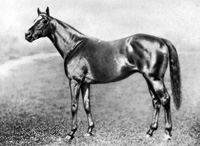 Flying Fox, Photograph by Clarence Hailey |
Flying Fox b c 1896 (Orme
- Vampire, by Galopin).
Family 7-d. Bred and owned by the 1st Duke of Westminster, Flying Fox was unplanned. His dam, Vampire (br f 1889) had been bred by J G Hodgson, and he kept her at Moorlands until her sale to Noel Fenwick for £1,200. Later she was purchased for 1,000 guineas for the Duke by John Porter. |
|||||||||||||||||||||
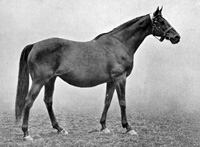 Vampire, Photograph by W A Rouch © Thoroughbred |
||||||||||||||||||||||
| John Huby, who was at Moorlands then, remembers her as "one of the
most unpromising animals in foalhood and early yearling days I can call
to mind". He described her as "when foaled, Vampire was somewhat on the
small side, and like many of Galopin's stock stood very much over at the
knees. She was also short coupled and had drooping quarters". Her looks
improved with age, although Mr Huby notes that when Mr Fenwick bought
her he saw her in the dark. She won several races and earned £875 prior
to her sale to the Duke. Vampire was possessed of a decidedly vile disposition. According to Richard Chapman, stud groom at Eaton, when Vampire arrived "the first time he [the Duke] went to look at her in her box after she had reached Eaton she backed towards him and tried to kick him. This caused His Grace to take a great dislike to her, and he seriously contemplated the idea of at once getting rid of her". Since she had killed her first foal, when her time came around for her impending foal it was decided to keep her at Eaton where the staff knew her. In due course the baby, Batt (br c 1895 Sheen, later finished 2° for Jeddah's Derby), arrived and the only stallion in residence was Orme, so he was used as her consort despite the close-in addition (2x3) of more "hot" Galopin blood. So, despite her lack of looks when young and her doubtful disposition she managed to produce a great triple crown winner. Vampire went onto have 5 more foals by Orme, the best of which were Ascot Derby winner Flying Lemur (b c 1899) and the Goodwood Prince Of Wales's Stakes winner Vamose (b c 1905). |
||||||||||||||||||||||
 |
||||||||||||||||||||||
|
||||||||||||||||||||||
 |
||||||||||||||||||||||
| Trained by John Porter,
he started almost every time as favourite, he was always ridden by
Mornington Cannon. He scared everyone in his second season by bolting
off each time the flag was raised before the 2000 Guineas, but the
patience of the starter is generally credited with getting him away.
Holocauste (gr c 1896 Le Sancy), a good winner
in France, was considered his main rival for the Derby, but broke his
leg during the race. In all Flying Fox ran 11 times and won 9 of these,
he was 2° twice, earning £40,090. When Flying Fox won the Eclipse Stakes
his winnings (£9,285) were donated to the Royal Alexandra Hospital at
Rhyl. In 1898, he won the New Stakes at Ascot by 3-4 of a length, beating Douglas Baird's future Oaks winner Musa (b f 1896 Martagon) and the Duke Of Portland's Dismay (b c 1896 St. Simon). He next won the Stockbridge Foal Stakes, beating R H Combe's No Trumps (b f 1896 Orvieto) by a length. His next engagement resulted in a 2° place finish to Leopold De Rothschild's St. Gris (b c 1896 Galopin) for the Imperial Produce Stakes at Kempton Park. He followed this with a 2° place finish to Lord W Beresford's American-bred Caiman (ch c 1896 Locohatchee) for the Middle Park Plate at Newmarket. In his final juvenile outing he won the Criterion Stakes at Newmarket Houghton by a length and a half, beating Arthur James's future Ascot Stakes winner Sinopi (b g 1896 Marcion) and Mr Fairie's Matoppo (b c 1896 Salisbury). In his first race of the 1899 season he won the 8f 2000 Guineas Stakes at Newmarket by 2 lengths, beating Caiman, Leopold De Rothschild's Trident (ch c 1896 Ocean Wave), and also Capt Greer's Birkenhead (b c 1896 Orme) and Lord Dunraven's Desmond (bl c 1896 St. Simon). Next out he won the 12f Derby at Epsom by 2 lengths, beating W R Marshall's Damocles (ch c 1896 Suspender) and J A Miller's Innocence (br c 1896 Simonian). Also among the field were the future Cesarewitch winner Scintillant (b c 1896 Sheen) and the future Irish Derby winner Oppressor (br c 1896 Gallinule). He then won the 8f Princess Of Wales's Stakes at Newmarket by 3 lengths, beating Lord Alington's Royal Emblem (b c 1896 Royal Hampton) and Prince Soltykoff's Ninus (b c 1895 Sheen). He also won the 10f Eclipse Stakes at Sandown Park by a length, beating his owner's Dewhurst Stakes winner Frontier (ch c 1896 Orme) and Ninus. He easily won the 14f+ St. Leger at Doncaster by 3 lengths, beating Caiman and Scintillant. He then won his last race of the season, the 10f Jockey Club Stakes at Newmarket by 4 lengths, beating Scintillant and Leopold De Rothschild's Choson (ch c 1896 Donovan). Following the death of the Duke, his horses were sold in 1900. Flying Fox was purchased by Edmond Blanc for 37,500 guineas and went to France. He entered the stud at Haras De Jardy where his fee was 600 guineas to foreign owners and he was not available to French owners. In his first crops he got Grand Prix De Paris winner Ajax (b c 1901), Middle Park Stakes winner Jardy (b c 1902) and Eclipse Stakes winner Val D'Or (b c 1902). Through Ajax his line was retained in France by Teddy (b c 1913) and Astérus (b c 1923), in Italy by Ortello (ch c 1926), and in America by Sir Gallahad (b c 1920) and Bull Dog (bbr c 1927). Flying Fox was Champion Sire in France in 1904, 1905 and 1913. He died on March 21, 1911, at Haras De Jardy. |
||||||||||||||||||||||
| Ajax (FR) | ||||||||||||||||||||||
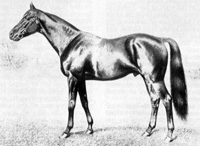 Ajax |
Ajax b c 1901 (Flying Fox - Amie, by Clamart). Family 2-i. | |||||||||||||||||||||
| Bred by Edmond Blanc,
Flying Fox was a full brother to Prix De La Foret winner Adam (ch c
1902) and a sister to Helene (ch f 1904), who became a good broodmare.
Their 2° dam Alice (br f 1887) was a half sister to the Grand Prix De
Paris winner Arreau (b c 1893 Clover). The line descends from the great
mare Crucifix (b f 1837
Priam). Edmond Blanc (1856-1920) was the most famous of French breeders for forty years. He inherited a great fortune from his father who was a professional gambler at Monte Carlo. When he became interested in owning and breeding race horses he first purchased a small stud, Haras De Bel Ebat at La Celle-Saint-Cloud, and when he outgrew this he established Haras De Jardy in Marnes-La-Coquette. He won the Prix Du Jockey Club 3 times and the Prix De Diane 5 times. |
||||||||||||||||||||||
|
|
||||||||||||||||||||||
|
||||||||||||||||||||||
 |
||||||||||||||||||||||
| Trained by Robert Denman, Ajax was the unbeaten winner of 5
races. He ran once as a juvenile and 4 times as three year old. He
earned £25,673 in France. In 1903 he won the 6f Prix Firmin at Chantilly by a length, beating Toison D'Or (gr f 1901 Le Sancy) and Truande (b f 1901 St. Bris). In 1904 he won the 12f Prix Noailles at Longchamp by a length, beating the future Prix Royal Oak winner Macdonald II (br c 1901 Bay Ronald) and Tentyra (b f 1901 Cyllene). He then won the 10f Prix Lupin at Longchamp "easily" by 2 lengths, beating Nature (b f 1901 Simonian) and Faconde (b f 1901 Callistrate). He next won the 12f Prix Du Jockey Club at Chantilly by half a length, beating Macdonald and the future Prix Ganay winner Rataplan (b c 1901 Ermak). In his final race he won the 15f Grand Prix De Paris at Longchamp by 1-2 a length, beating Grand Prix De Deauville winner Turenne (ch c 1901 Le Hardy) and Macdonald. Among the field was Poule D'Essai Des Poulains and Grand Prix De Saint-Cloud winner Gouvernant (ch c 1901 Flying Fox). He sustained an injury after the Grand Prix De Paris which terminated his racing career and he retired to Haras De Jardy. Among his sons, a number spring to mind, including (1) Gouvernant (ch c 1901) won the Poule D'Essai Des Poulains, Grand Prix De Saint-Cloud and Grosser Preis Von Baden. He was sent to Austria-Hungary in 1905 and was a champion sire there in 1913 (2) Jardy (b c 1902) won the Middle Park Stakes and Prix Noailles, and went on to become a champion sire in Argentina in 1919 (3) Val D'Or (b c 1902) won the Prix Morny, Eclipse Stakes and Poule D'Essai Des Poulains. He also went to Argentina and was a useful stallion there (4) Fils Du Vent (b c 1906) won the Prix Robert Papin and Grand Criterium D'Ostende, after which he went Poland and was in the stud there for many years (5) Dagor (b c 1910) won the Poule D'Essai Des Poulains and the Prix Du Jockey Club, from there he went to Austria-Hungary and was still in the stud 20 years later, and (6) His most significant son was probably Teddy (b c 1913), an excellent race horse and stallion, and sire of Sir Gallahad and Bull Dog who made such an impression in America. He got numbers of good daughters, including (1) Azalée (ch f 1906), winner of the Criterium De Maisons-Laffitte, Prix La Rochette and DH Grosser Peris Von Baden, dam of Grand Prix De Saint-Cloud (twice), Prix Du Cadran and Prix Ganay winner and good stallion, Nino (ch c 1923 Clarissimus) (2) Hors Concours (b f 1906), dam of the stallion Havresac (br c 1915 Rabelais), he got Cavaliere D'Arpino (b c 1926) a good stallion in Italy, but he was probably better known as the sire of Nogara (b f 1928), dam of Nearco (br c 1935 Pharos) (3) Union (b f 1906), winner of the Prix De Diane, Prix Greffulhe, and Prix Miss Gladiator, ancestress to Italian triple crown winner Gladiolo (ch c 1943 Navarro) and Prix Du Jockey Club, Prix De L'Arc De Triomphe and Grand Prix De Paris winner Le Pacha (b c 1938 Biribi) (4) Ajantia (b f 1907), dam of Ascot Gold Cup (twice) and Jockey Club Cup Stakes winner Invershin (b c 1922 Invincible) (5) La Campanilla (ch f 1908), dam of Prix Du Jockey Club and Prix Noailles winner Le Corrège (ch c 1925 Dominion) (6) Mauri (ch f 1909), dam of Ascot Gold Cup, Prix De L'Arc De Triomphe and Prix Ganay winner Massine (b c 1920 Consols), later a champion sire in France (7) La Flambée (b f 1912), ancestress of such horses as American triple crown winner Omaha (ch c 1932 Gallant Fox); Newmarket, Champion, Princess Of Wales's Stakes and Ascot Gold Cup winner Flares (b c 1933 Gallant Fox); Belmont Stakes winner and Champion Three Year Old Colt Phalanx (b c 1944 Pilate) and Kentucky Derby and Belmont Stakes winner Johnstown (b c 1936 Jamestown). Ajax died in 1915 at the age of fourteen. |
||||||||||||||||||||||
| Teddy (FR) | ||||||||||||||||||||||
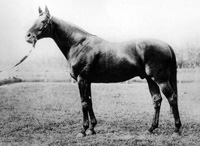 Teddy |
Teddy b c 1913 (Ajax -
Rondeau, by Bay
Ronald). Family 2-n. Teddy was bred at Haras De Jardy by Edmond Blanc. Blanc sold all his yearlings in 1914 prior to the arrival of the German army. He was purchased by J D Cohn for 5,400 French Francs. Captain Jefferson Davis Cohn (1881-1951) was said to be a "remarkably colourful" character. He never refuted the story that he had been born in the deep south of America, possibly Mississippi or Alabama, and was the godchild of Jefferson Davis, who had been president of the Confederate States Of America during the Civil War. Cohn spent his youth in Whitechapel (London) where he was "the favourite of a wealthy nobleman" from who he received a legacy that gave him his start. His dam, Rondeau (b f 1900), did not have a classics winner in her tail-female line for nearly a hundred years, her 8° dam Bronze (br f 1803 Buzzard) won the Oaks Stakes. She had arrived in Bay Ronald's first crop and she started her turf career much like her sire had, as a selling plater, first purchased by J Watts for 300 guineas, then by Sir James Miller for 500 guineas. She ran 20 races in all and won 9 of these. She won the Dullingham Plate at Newmarket twice. In 1904, as a 4 year old, she finished 2° for the 2m 2f Cesarewitch Stakes at Newmarket, won by Horatio Bottomley's Ebor Handicap winner Wargrave (b c 1898 Carbine) by 1 and a half lengths, beating J C Sullivan's War Wolf (b c 1899 Wolf's Crag) by a head. She gave Wargrave 14 pounds. She also finished 2° for the ~2m King's Plate at Derby, won by Major Eustace Loder's future Cesarewitch winner Hammerkop (b f 1900 Gallinule) by a length, beating F Alexander's Ascot Gold Cup winner Throwaway (b c 1899 Right-Away) by 4 lengths. After Sir James Miller's death in 1906 part of his stock was sold at the Newmarket December Sales. Rondeau, covered by Miller's triple crown winner Rock Sand (br c 1900 Sainfoin) went to Edmond Blanc for 4,000 guineas as the second high seller. The high seller of the sale was 1000 Guineas winner Aïda (b f 1898 Galopin), also covered by Rock Sand, who was purchased by Sir T Sykes for 4,300 guineas. |
|||||||||||||||||||||
|
|
||||||||||||||||||||||
|
||||||||||||||||||||||
|
|
||||||||||||||||||||||
| Teddy ran for 2 years,
but did not race
until he was 3 years old due to the war. He was rained by Robert Denman,
who also trained his sire. He ran 8 races and won 6 of these, earning 150.300
French Francs. France had no racing in 1915 or at the beginning of
1916, so Teddy went to Spain. In 1916 won the 12f Gran Premio De San Sebastián by 3 lengths, beating Cohn's Spirit who gave Teddy 26 pounds, and 24 others. Won the (about) 12f Premio Villamejor (St Leger) at San Sebastián beating 3 others, 2 of them belonging to Cohn. Next he finished 3° for the 12f La Coupe Du Roi D'Espagne (or King Of Spain's Gold Cup) to stablemate Rabanito (br f 1913 Cupbearer). Back in France, where racing resumed for the first time since the beginning of the war in August of 1914, he won the 11f Prix De Darbonnay at Moulins. Two days later he then won the 11f Prix De Darnay also at Moulins. Six days later he won the 12f Prix Des Trois Ans (a wartime substitute for the Prix Du Jockey Club) run at Moulins. He next finished 3° for the 12f Prix De L'Elevage, won by W K Vanderbilt's Antivari (b c 1913 Sea Sick) and Baron Rothschild's Sans-Le-Sou (ch c 1910 Sans Souci). In 1917 he won his only start, the 10f Prix Des Sablonniers by a neck, beating Baron Rothschild's La Farina (ch c 1911 Sans Souci) at level weights. Teddy retired to his owner's Haras De Chamant, near Senlis, France, and appeared to be a success from the beginning. He had numerous good sons, with the best of them being Ortello (ch c 1926) who won the Derby Italiano and Prix De L'Arc De Triomphe. Other good sons include (1) Sir Gallahad (b c 1920), won the Poule D'Essai Des Poulains, Prix Jacques Le Marois and in England, the Lincoln. Sent to America he was a leading sire in 1930, 1933, 1934 and 1940 (2) Aethelstan (b c 1922), was 3° on the French sires list in 1936 and sent to America the same year (3) Astérus (b c 1923), winner of the Poule D'Essai Des Poulains, Prix Greffulhe, the Champion Stakes and the Royal Hunt Cup, he was the champion sire in France in 1934 (4) Brumeux (b c 1925), winner of the Jockey Club Cup Stakes at Ascot and the Newbury Autumn Cup, he was a useful stallion in England and (5) Bull Dog (bbr c 1927), was sent to America and led the sires list in 1943. After Teddy was sent to America in 1931, the best of his get there were Arlington Futurity and Illinois Derby winner Case Ace (b c 1934) with earnings of $49,830 and Sun Teddy (ch c 1933) with earnings of $24,000. Case Ace got Belmont and Jockey Club Gold Cup Stakes and Massachusetts Handicap winner Pavot (br c 1942). Sun Teddy got Sun Again (ch c 1939), who got Sunglow (ch c 1947), who in turn got Horse Of The Year Sword Dancer (ch c 1956) and he got Horse Of The Year Damascus (b c 1964). Teddy had many good daughters, among them (1) Marguerite De Valois (b f 1919), full sister to Sir Gallahad, was ancestress to Metropolitan Stakes winner Fappiano (b c 1977 Mr. Prospector) who had much promise as a stallion but died far too young (2) Anna Bolena (b f 1920), winner of the Poule D'Essai Des Pouliches, dam of Prix Royal Oak winner Jumbo (b c 1930 Zambo) and Mary Tudor, winner of the Poule D'Essai Des Pouliches, Prix Vermeille and Prix D'Harcourt, and dam of Derby and Ascot Gold Cup winner Owen Tudor (br c 1938 Hyperion) (3) Coeur A Coeur (ch f 1921), grandam of 2000 Guineas, Poule D'Essai Des Poulains and Prix De L'Arc De Triomphe winner Djebel (b c 1937 Tourbillon). Djebel was champion sire in France in 1949 and 1956 (4) Persephone (br f 1921), dam of Prix D'Harcourt winner (twice) and Prix Ganay winner Amfortas (b c 1927 Ksar). Amfortas got For My Love (b f 1936), the dam of Derby winner My Love (b c 1945 Vatellor) (5) Queen Iseult (br f 1924), was the dam of City And Suburban winner William Of Valence (br c 1932 Vatout), 2000 Guineas winner Le Ksar (b c 1934 Ksar) and Cesarewitch winner Cantatrice (br f 1935 Fiterari) (6) La Troienne (b f 1926), one of the most important fillies to go to America, she was the dam of CCA Oaks and American Derby winner Black Helen (b f 1932 Black Toney) and Preakness and Belmont winner Bimelech (b c 1937 Black Toney). She founded a family of winners unprecedented in that country (7) Rose Of England (br f 1927), bred by Lady James Douglas, she won the Oaks Stakes and in the stud produced the St. Leger winner Chulmleigh (b c 1934 Singapore) and the champion sire in Argentina in 1947 and 1954, British Empire (br c 1937 Colombo) (8) Philippa Of Hainault (br f 1932), ancestress of such horses as Prix De Diane winner Belle Sicambre (b f 1961 Sicambre), Derby and Grand Prix De Paris winner Phil Drake (b c 1952 Admiral Drake), and Ascot Gold winner Pardallo (b c 1963 Pardal) and (9) Tara (ch f 1932) ancestress of good winner Worden (ch c 1949 Wild Risk), good winner and stallion Norseman (ch c 1940 Umidwar) and Prix Du Jockey Club winner Le Fabuleux (ch c 1961 Wild Risk). Teddy was a champion sire in France in 1923, 2° in 1926, 1928 and 1932, 3° in 1925. He was 2° in Italy in 1929 when Ortello won the Arc. He was champion broodmare sire in France in 1942. He was sent to America in 1931, purchased by F Wallis Armstrong and Kenneth Gilpin. He died July 12, 1936, at Gilpin's Kentmere Farm in Boyce, Virginia. |
||||||||||||||||||||||
| Orby (GB) | ||||||||||||||||||||||
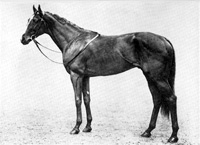 Photograph by Clarence Hailey  Richard "Boss" Croker (1841-1922) Croker retired from his "Tammany Hall" political organisation to Berkshire, in England, where he planned to enjoy racing his horses. Discouraged by the Newmarket Jockey Club he removed himself and his horses to his native Ireland, whereby Orby became the first Irish-trained Derby winner. |
Orby ch c 1904 (Orme - Rhoda B., by Hanover). Family 26. | |||||||||||||||||||||
| Bred and owned by Richard Croker,
he was a half brother to 1000 Guineas winner
Rhodora (br f 1905 St. Frusquin). Croker purchased their dam, Rhoda B.
(br f 1895 Hanover), as a yearling from Colonel Milton Young in
Lexington, Kentucky. She was a full sister to The Commoner who won 18
races in America. She ran 5 times in England, winning the Exning Plate
at Newmarket. Although foaled in England, Orby was the first Irish-trained horse to win the Derby. His trainer, Frank McCabe, in a letter to the Irish Field, retold the story of Orby's return to Ireland after winning the Derby at Epsom. Orby and his lad Hayden arrived at Foxrock Station, near Dublin, and were met by a brass band. McCabe joined them at Glencairn Gate where an old lady rushed over to him, blessing him with the words "Thanks be to God and you, sir, we have lived to see a Catholic horse win the Derby". For his part, Mr Croker was displeased that McCabe had not arranged for HM the King to congratulate him on his victory which he considered a right of an owner of a Derby winner. However, he did give McCabe a "nice mare", Leucosia, for him to ride in the Military Race at Leopardstown for a cup given by HM the King. |
||||||||||||||||||||||
|
|
||||||||||||||||||||||
|
||||||||||||||||||||||
|
|
||||||||||||||||||||||
| He was trained by J J
Parkinson for his juvenile season which was necessarily short, to
accomodate Orby's poor feet on hard ground that summer at the Curragh.
Of course he was tried privately and his connections were well aware of
his ability, still he had no wins from his 2 starts. He was then trained
by Colonel
Francis McCabe at Glencairn and as a three year old he won 4 races from
7 starts earning £7,840. In 1906 in his first outing he finished 3° for the 5f Londonderry Plate at Leopardstown, won by T K Laidlaw's Gleg (b c 1904 Bushey Park) and W McAuliffe's Affiant (b c 1904 Laveno). Next he finished 3° for the 6f+ Railway Stakes at the Curragh, won by Croker's Electric Rose (br f 1904 Lesterlin) and D Shanahan's Silver Fowl (ch f 1904 Wildfowler). In 1907 he won the 7f Earl Of Sefton's Plate at Liverpool by 3 lengths, beating C Hibbert's Pane (b c 1903 Martagon) and Lord Derby's Persinus (b g 1902 Matchmaker). He next won the 1 1-2 m Baldoyle Plate at Dublin by 6 lengths "in a canter", beating J J Parkinson's Galloping Girl II (ch f 1904 St. Gris) and Sir E C Cochrane's Mr. Popple (bbl c 1904 St. Aidan). He then won the 1 1-2 m Derby at Epsom by 2 lengths, beating Col E W Baird's future St. Leger winner Wool Winder (b c 1904 Martagon) and Capt Greer's favoured 2000 Guineas winner Slieve Gallion (bbl c 1904 Gallinule). He also won the 1 1-2 m Irish Derby at the Curragh by 4 lengths, beating Croker's Georgetown (b c 1904 Teufel) and T K Laidlaw's Gleg. In his final outing for the year he was unplaced for the 1m 1f Atlantic Stakes at Liverpool, won by W Clark's Linacre (b c 1904 Wolf's Crag) and J B Joel's Earlston (ch c 1904 Love Wisely). He retired to Glencairn Stud, Sandyford, County Dublin, where he covered from 1908-1917, his fee rising from £98 to £200. His stock racing in England was limited by WW I. The Daily Racing Form of June 11, 1909, described him: "Orby has improved to a wonderful degree in appearance since his retirement to the stud. A handsomer horse it would be difficult to find anywhere. Among the changes that have taken place is an appreciable darkening of his coat. He is now a deep, rich chestnut. But of more consequence is the development of his frame. His quarters and thighs are strikingly powerful". His best winner was Diadem (ch f 1914), bred and raced by Lord D'Abernon. She won the Eton Stakes, New Coventry Stakes, Fulbourne Stakes, Moulton Stakes, 1000 Guineas Stakes, Rous Memorial Stakes twice, July Cup twice, Great Eastern Railway Handicap, and placed 2nd in the Oaks Stakes. Other winners of note include (1) Diadumenos (ch c 1910) winner of Great Jubilee Handicap, Liverpool Autumn Cup (2) Eleanor M. (ch f 1913) winner of Nursery Plate, Autumn Stakes (3) Eos (br f 1913) winner of Soltykoff Stakes, Moulton Stakes, Manor Handicap, July Handicap, Falmouth Stakes, Cambridgeshire Stakes (4) Glanmerin (ch c 1916) winner of Middlesex Handicap, Sussex Stakes, Stewards' Handicap, Portland Plate (5) Grand Parade (bl c 1916) winner of Anglesey Stakes, Fitzwilliam Stakes, Soltykoff Stakes, National Produce Stakes, Derby Stakes, St. James' Palace Stakes (6) Lady Phoebe (b f 1917) winner of Claremont Plate, Acorn Stakes and (7) Orpheus (br c 1917) winner of New Stakes, Berkshire Foal Stakes, Fulbourne Stakes, Prendergast Stakes, Duke of York Stakes, Champion Stakes, Duke of Cambridge Stakes, Princess of Wales' Stakes, Limekiln Stakes, 3rd Derby Stakes. He also got several good stallion sons such as The Boss (ch c 1910) and Flying Orb (ch c 1911). Orby died at the Glencairn Stud, on April 5, 1918. He was only 14 years old. |
||||||||||||||||||||||
|
|
||||||||||||||||||||||